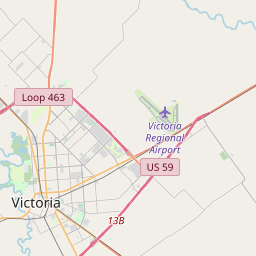Site of Southern Pacific Railroad Depot
Historical marker location:






The coming of the railroad to Victoria was an important part of the town's economic and social history. Although the first line reached Victoria by 1860, the railroad's major impact came after the end of the Civil War.
In 1882, the proposed New York, Texas & Mexican Railroad completed a stretch of track from Rosenberg to Victoria and established its line headquarters here. Three years later it was sold to the Southern Pacific Railroad Company. Southern Pacific built a depot at this site in 1888-89 to serve arriving and departing passengers and to house its headquarters. Later, Victoria served as division headquarters for the Galveston, Harrisburg & San Antonio Railroad.
The two-story depot had a baggage room, waiting rooms, and ticket offices on its first floor, with the divisions' general offices and the dispatcher housed on the second floor. It often served as a gathering place for community social functions.
The last passenger train left Victoria in 1953, but the depot remained in use for various purposes until 1979. Although the depot burned in 1984, its history is a reminder of the railroad's importance as a vital part of the economic and physical growth of Victoria. (1986)
Texas Sesquisentennial 1836-1986
As one of the most visible programs of the Texas Historical Commission (THC), historical markers commemorate diverse topics in Texas history, including: the history and architecture of houses, commercial and public buildings, religious congregations, and military sites; events that changed the course of local and state history; and individuals who have made lasting contributions to the state, community organizations, and businesses.
The cattle industry played a significant role in the development of Texas, with cowboys driving cattle from Texas to railheads in Kansas during the late 1800s and early 1900s.
In the early 19th century, Anglo-American settlers began to move into the area, attracted by the fertile land for agriculture and the potential for ample grazing. The Mexican government encouraged colonization, and by 1834, there were around 100 families living in the region. However, tensions between the settlers and the Mexican government eventually led to the Texas Revolution in 1835.
During the Texas Revolution, Victoria became a strategic point for both the Texian and Mexican armies. The Battle of Guadalupe River occurred here in 1835, where the Texian rebels under the command of George Collingsworth captured the Mexican garrison without bloodshed. The town of Victoria formally became the capital of the Republic of Texas in 1839 before it was moved to Houston and later Austin.
In the late 19th and early 20th centuries, Victoria County experienced significant growth and development. The railroad arrived in the late 1800s, leading to increased trade and the expansion of the local economy. The discovery of oil in the early 20th century further contributed to the county's prosperity. Today, Victoria County is a thriving hub for agriculture, oil and gas production, and serves as a regional center for healthcare, education, and businesses.
Victoria County Timeline
This timeline provides a condensed summary of the historical journey of Victoria County, Texas.
- 1824 - Victoria County is established as a Municipality of Mexico
- 1836 - Texas gains independence from Mexico
- 1837 - Victoria County is created as an original county of the Republic of Texas
- 1852 - The town of Victoria becomes the county seat
- 1860 - Population of Victoria County reaches 2,305
- 1874 - The Texas Mexican Railway expands into Victoria County, stimulating economic growth
- 1899 - Oil is discovered in the county, leading to a boom in the petroleum industry
- 1924 - The DuPont Company establishes a plant in Victoria County, contributing to industrial development
- 1930 - Population of Victoria County exceeds 30,000
- 1952 - The O'Connor-Proctor Building, the first air-conditioned building in town, is constructed
- 1960 - Victoria County Courthouse is added to the National Register of Historic Places
- 2008 - Hurricane Ike causes extensive damage to Victoria County
- 2019 - Victoria County celebrates its 182nd anniversary